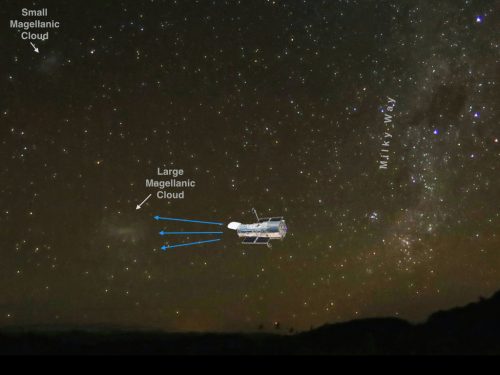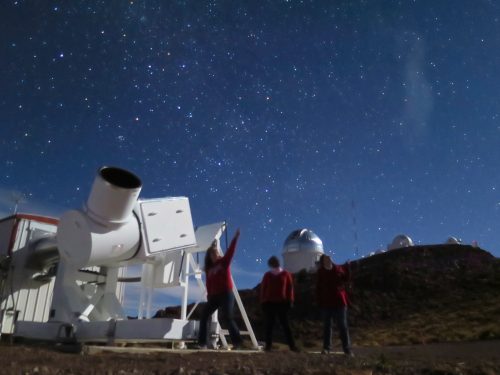Eclipsing Research
TCU astronomer Kat Barger shines a light on the Milky Way’s origins.
Eclipsing Research
TCU astronomer Kat Barger shines a light on the Milky Way’s origins.

Kat Barger, assistant professor of astronomy at TCU, specializes in studying the process of new star formation. Photo by Carolyn Cruz
About 4 1/2 billion years ago, at cosmic distances that are difficult to fathom, a star collapsed in on itself and exploded. Within 20 minutes of the core’s collapse, a shockwave streamed through the star’s surface in a burst of light that shone 130 million times brighter than the sun.
Gravity drew those gases together into what’s called a molecular cloud, pushing them closer and closer until they grew denser and collapsed, much like the supernova that produced them. As more gas collected, it started to spin, eventually flattening into a disk like a pancake. At its center burned the faint young sun.
If that distant supernova had not exploded, the gas that became the sun and solar system might not have made it into the Milky Way. It might have remained in a much more distant galaxy, never to travel through intergalactic space and eventually become planets and asteroids and people.
Supernovae are vital movers of the gas that powers galaxies, said Kat Barger, assistant professor of astronomy at TCU. “You need gas to make stars. We are tracking the star-formation ability of galaxies.”
Barger’s research at TCU focuses on tracing the journey of this gas, especially gas found in the Large Magellanic Cloud, a small companion galaxy to the Milky Way. From the Southern Hemisphere, the Large and Small Magellanic Clouds are visible as purplish smudges of light, but they are actually distant dwarf galaxies.

Illustration showing the Hubble Space Telescope superimposed on an image of the Milky Way and the Large and Small Magellanic Clouds. Created by Kat Barger
Using the Hubble Space Telescope, Barger and her team of undergraduate and graduate students determined that supernovae are shoving gas out of those galaxies, enabling the Milky Way to steal it and forge new stars just like the sun.
Flashlights
Like most modern astronomers, Barger typically doesn’t observe the cosmos through a telescope on a clear night. Instead, she uses supercomputers to crunch vast amounts of data. And she is one of a legion of astronomers who doesn’t even use visible-light images — at least not the type most people expect.
Barger and her team use a method called spectroscopy to view the Large Magellanic Cloud, the gas and the space between. It’s based on the fact that any regular matter (as distinct from mysterious, invisible dark matter) absorbs light. With an instrument on Hubble called the Cosmic Origins Spectrograph, Barger can see the gas by detecting the light it absorbs from other sources.
“I use bright background flashlights, and they interact with the gas clouds that I’m looking at,” she said. “It’s really the absence of light that I’m studying — which is weird.”
Barger’s flashlights are distant objects called quasars, which are active centers of distant galaxies far behind the Large Magellanic Cloud, as viewed from Hubble’s perch in Earth’s orbit.
When the light from quasars shines through Large Magellanic Cloud gas, some of the light is absorbed, depending on the presence of individual elements. Each element absorbs light in a distinct pattern, which looks somewhat like a bar code or a set of dark lines. By looking at the bar codes and how they are offset, Barger and her team can tell what is in the gas, which direction it’s flowing and more.
Hubble observed the Large Magellanic Cloud on her behalf on the night of June 29 and again Aug. 3. She and her collaborator, Andrew Fox, an astronomer at the Space Telescope Science Institute, had Hubble’s findings in their inboxes the next morning.
“Since we’re doing spectroscopy, we don’t see the pretty pictures. We see squiggly lines,” Barger said. “By looking at how much the color of the light changes, I can tell its motions. I can tell how hot the gas is, how ionized the gas is — meaning how many electrons have been popped off.”
Barger used observations like these to look at the back side of the Large Magellanic Cloud. For the first time, she observed gases getting kicked out of the far side of the galaxy as well as the near, Milky Way-facing side. This confirmed that supernovae are driving the gas out of the Large Magellanic Cloud and sending it into intergalactic space.
Superbubbles
Strong extragalactic gas flows are probably caused by a phenomenon called superbubbles, a term for groups of supernovae occurring in the same cosmic neighborhood. Other research teams have confirmed superbubbles’ presence in the Large Magellanic Cloud, but Barger’s work was the first to show their effects.

Left to right: graduate student Brianna Smart from the University of Wisconsin-Madison, Jacqueline Antwi-Danso (TCU undergrad), and professor Kat Barger stand in front of the Wisconsin H-alpha Mapper telescope, which measures diffuse light from the Milky Way. The telescope is located at Cerro Tololo Inter-American Observatory in northern Chile. Antwi-Danso traveled to CTIO on a TCU SERC grant. Photo courtesy of Kat Barger
Barger also realized that they were creating intergalactic tides, in which gas was flowing among the Large Magellanic Cloud, the Small Magellanic Cloud and the Milky Way. The tides are the result of gravity and angular momentum, just like tides in Earth’s oceans — but much more powerful, Barger said. “Imagine the oceans rising and falling so much that the oceans got ripped off the Earth and traveled to the moon.”
Fox said gravity is the most important factor in determining the life cycle of stars and galaxies. He and Barger are focused on the driving forces behind gravity’s ability to act in the first place. Supernovae, active galactic nuclei — Barger’s flashlights themselves — and galactic winds all play a role in moving gas around.
Barger’s team has shown that the Magellanic Clouds are ejecting the equivalent of 10 million times the mass of the sun in gas. All of these titanic forces and flows are very good news for the Milky Way. Gas is fuel. Without an intergalactic fill-up, the Milky Way would eventually burn out.
“The gas plays a key role in the way galaxies work,” Fox said. “If you don’t have these gases moving around, you eventually can’t form stars. This is a question of active research; it’s all about fueling the galaxy.”
The Story of Us
The story of that fuel is also the story of us.
During the summer, researchers at Northwestern University in Chicago used similar data to turn back the clock on these gas flows. Their supercomputer simulations showed that, contrary to previous understanding, up to half of the material in the Milky Way may have originated in distant galaxies. Each of us is not only star stuff, but perhaps very, very old and very distant star stuff indeed.
Observations such as Barger’s are important for making sure those computers are correct, Fox said. “There are two sides to this. You have very high-intensity supercomputer simulations to investigate how gas moves in and out of galaxies, and then at the same time, you have observers who use telescopes to actually trace what’s happening,” he said. “The observations are what anchors us to the real universe.”
In addition to Hubble, Barger uses radio telescopes to track the movement of gas in the Milky Way, Large and Small Magellanic Clouds, and extragalactic clouds, such as a small formation near the Milky Way known as Complex A.
To trace gas, she uses a telescope called the Wisconsin H-Alpha Mapper, or WHAM, which was custom-built to study widespread, diffuse light from the Milky Way. Barger took a graduate student and an undergraduate student to Chile to visit the telescope.

Students observe the 2017 partial solar eclipse with their TCU-branded protective eyewear. People gathered at the Campus Commons to see the eclipse through special telescopes and watch live feeds of total-eclipse paths. Photo by Amy Peterson
Along with studying gas flows that lead to the birth of stars, Barger spent much of 2017 preparing for a temporary disappearance of our star: a total solar eclipse crossing the U.S. for the first time in nearly a century.
For the solar eclipse Aug. 21, Barger planned to use a special filter on the TCU astronomy department’s telescopes that blocks all but the same wavelength of light as the WHAM telescope — to allow people to safely view the partially eclipsed sun.
“Astronomers these days don’t put your eye to the eyepiece; you put your eye to the computer monitor because the light is hitting the [detector],” Barger said. “So I seldom look through a telescope, but I’m looking forward to observing the eclipse.”
Using observations of intergalactic gas, astronomers are learning even more about where our star came from — and how new ones will continue forming far into the future.

Your comments are welcome
Comments
Related reading:
Campus News: Alma Matters
Understanding Cosmic Origins
A course on the history of the universe.
Features
Secrets of the night sky
TCU astrophysics team helps map the universe.
Alumni
A man, the moon and a volcano
Hawaii teacher Justin Brown ’09 and his robotics program students are helping NASA test technology to repel lunar dust.